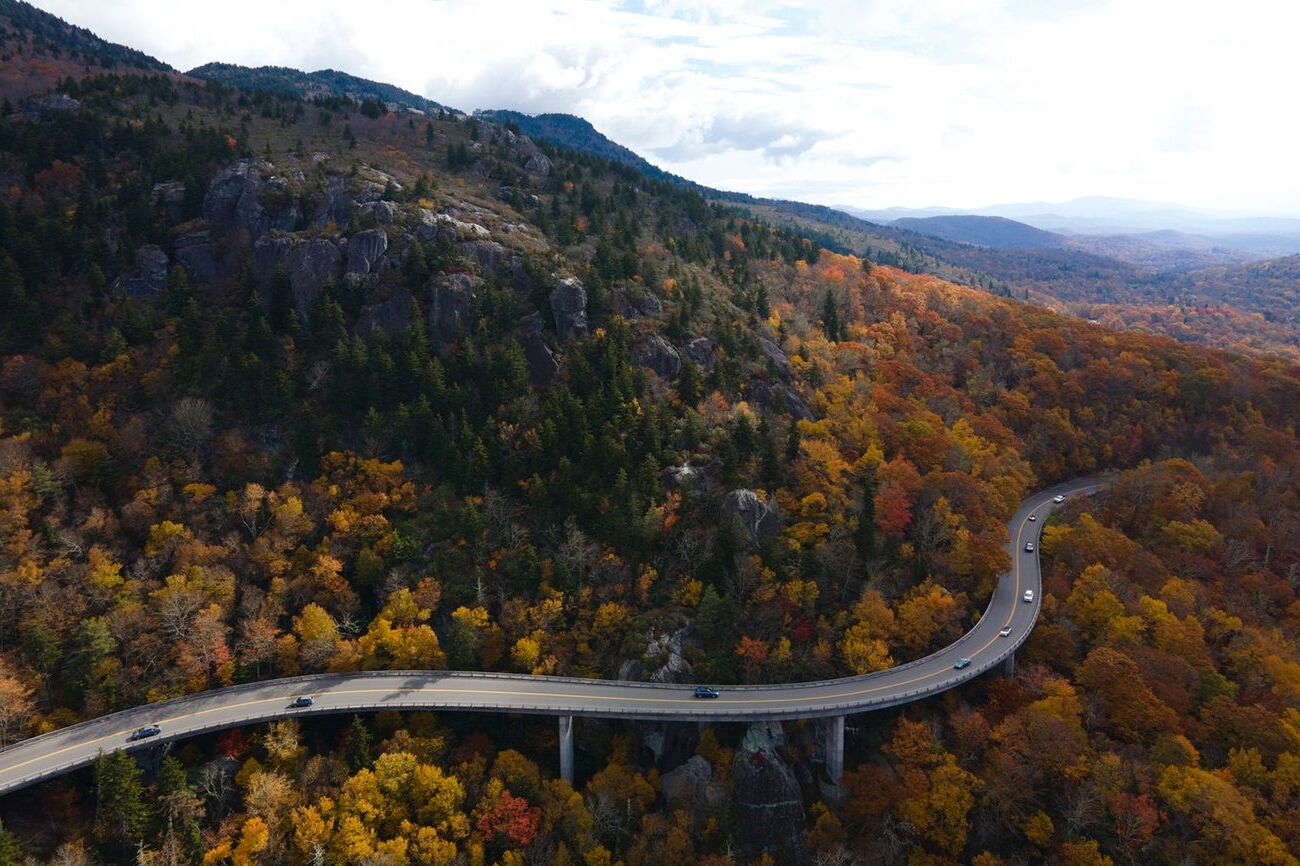
Why is the Blue Ridge Parkway one of the most iconic scenic drives in the United States? Stretching 469 miles from Shenandoah National Park in Virginia to Great Smoky Mountains National Park in North Carolina, the Blue Ridge Parkway offers breathtaking views and a rich history. This recreational motor road, designated in 1936, was designed to blend seamlessly with the Appalachian Mountains. With an elevation range from 649 feet to nearly 6,050 feet, it features diverse ecosystems, including 100 tree varieties and 159 bird species. The parkway also boasts 26 tunnels, 168 bridges, and numerous historical sites, making it a must-visit for nature lovers and history buffs alike.
Key Takeaways:
- The Blue Ridge Parkway is a 469-mile scenic drive connecting Virginia and North Carolina, offering diverse ecosystems, historical significance, and a haven for threatened species.
- The parkway's construction during the Great Depression involved local labor, New Deal-era agencies, and a design philosophy focused on minimal environmental impact, making it a unique and cherished American landmark.
The Blue Ridge Parkway: A Scenic Marvel
The Blue Ridge Parkway is more than just a road; it's an experience that captures the essence of the Appalachian Mountains. Stretching from Virginia to North Carolina, this iconic drive offers breathtaking views, rich history, and diverse ecosystems. Let's dive into some fascinating facts about this beloved scenic route.
-
Length and Route: The Blue Ridge Parkway spans 469 miles, connecting Shenandoah National Park in Virginia with Great Smoky Mountains National Park in North Carolina.
-
Designation: Formally designated as the Blue Ridge Parkway under the National Park Service (NPS) on June 30, 1936.
-
Purpose: Designed as a recreational motor road, focusing on leisure travel and scenic beauty rather than commercial use.
Ecological Diversity and Conservation
The Blue Ridge Parkway is a haven for nature lovers. Its diverse ecosystems and conservation efforts make it a critical habitat for many species.
-
Ecological Diversity: One of the most ecologically diverse areas in the world, featuring about 100 varieties of trees, 1,600 plant species, 54 mammals, and 159 species of birds.
-
Threatened Species: Provides critical habitat for over 50 threatened and endangered plant species.
Construction and Historical Significance
The parkway's construction is a story of perseverance and vision, involving numerous agencies and local labor during the Great Depression.
-
Construction Start: Began on September 11, 1935, with 100 men preparing the land for the road.
-
Initial Funding: The first contract was awarded to Nello Teer Construction Company of Durham, North Carolina, for over $316,000 during the Great Depression.
-
Construction Agencies: Involved several New Deal-era agencies, including the Works Progress Administration (WPA), Civilian Conservation Corps (CCC), and Emergency Relief Administration (ERA).
-
Local Labor: About 90% of the hand labor came from nearby creeks and coves, with local laborers paid 30 cents an hour, working six days a week.
Design Philosophy and Features
The parkway's design philosophy aimed to blend seamlessly with the natural landscape, ensuring minimal environmental impact.
-
Design Philosophy: Fit into the mountains “as if nature has put it there,” ensuring minimal impact on the environment.
-
Speed Limit: Never higher than 45 miles per hour, with lower limits in many places to ensure safety and enjoyment.
-
Elevation Range: Ranges from 649 feet at James River in Virginia to almost 6,050 feet at Richland Balsam, south of Mount Pisgah, North Carolina.
-
Tunnels and Bridges: Features 26 tunnels and 168 bridges, with six viaducts, to cross streams, railways, and other obstacles.
-
Highest Point: The highest point on the parkway is at an elevation of 6,047 feet, south of Waynesville, North Carolina, near Mount Pisgah.
Natural Heritage and Visitor Experience
The parkway is not just about the drive; it's about the experience and the natural heritage it preserves.
-
Natural Heritage Areas: Within the boundaries are 47 Natural Heritage Areas set aside as national, regional, or state examples of exemplary natural communities.
-
Visitor Numbers: The most visited unit of the U.S. national park system, with over 15 million visitors annually.
Historical Roots and Federal Interest
The idea of the parkway has roots in early 20th-century proposals and gained momentum during the Great Depression.
-
History of Construction: The proposal to build a private toll road along the Blue Ridge was first put forth by Joseph Hyde Pratt, a North Carolina geologist, in the early 20th century.
-
Initial Construction: Construction of a segment in North Carolina began in 1912 but ceased during World War I. The current parkway follows some of that original route near Linville Falls.
-
Federal Interest: Federal interest in the highway was kindled during President Franklin D. Roosevelt's administration, which saw it as a public works project during the Great Depression.
-
Surveying and Lobbying: Extensive surveying and lobbying efforts by interested parties led to the final route being approved by Congress.
Land Acquisition and Early Sections
The process of acquiring land and constructing the early sections of the parkway involved collaboration between states and the federal government.
-
Land Acquisition: The states were to acquire rights-of-way while the federal government provided funding for design, supervision, and construction.
-
First Section: The first section extended south near the Virginia-North Carolina state line and began on September 11, 1935.
-
National Park Service Jurisdiction: Taken into the National Park Service on June 30, 1936, marking it as a resource of national merit.
Construction Phases and Post-War Development
The parkway's construction spanned several decades, with significant progress made post-World War II.
-
Policy Governance: The parkway's policy has been governed by the National Park Service to conserve scenery, natural and historic objects, and wildlife, ensuring they remain unimpaired for future generations.
-
Construction Phases: Undertaken in noncontiguous segments along its route, largely by private contractors, with ancillary work done by New Deal agencies like the WPA and CCC.
-
World War II Impact: Work on the road slowed dramatically with the U.S. entry into World War II, but some activities continued with conscientious objectors.
-
Post-War Resumption: Construction resumed in the mid-1950s as part of Mission 66, a comprehensive NPS program to improve its properties systemwide. Nearly all remaining segments were completed over the next decade.
Amenities and Final Sections
The addition of amenities and the completion of challenging sections like the Linn Cove Viaduct marked the final phases of the parkway's development.
-
Amenities Addition: During this period, amenities like visitors’ centers, dining and lodging facilities, and campgrounds were added to enhance visitor experience.
-
Grandfather Mountain Link: One of the final and most challenging links of the parkway was a stretch around Grandfather Mountain in North Carolina, completed in 1979–82. The Linn Cove Viaduct was a notable construction feat.
-
Ecosystem Preservation: The Linn Cove Viaduct was designed to minimize damage to the area’s fragile ecosystem, using a cantilever technique to place prefabricated support beams and roadbed sections.
Variety of Experiences and Attractions
The parkway offers a variety of experiences and attractions, making it a unique and enjoyable drive for millions of visitors each year.
-
Variety of Experiences: The design philosophy included creating a variety of experiences along the route, referred to as “the spice” of the parkway. This ensured wide, sprawling landscapes as well as closer, more intimate views of natural phenomena.
-
Attractions and Structures: Features 91 buildings, two historical sites, and 133 other structures, many of which illustrate life in the mountains prior to the parkway’s construction. Some structures were even moved to sit along the route to symbolize “pioneer Appalachia”.
-
Historical Sites: The Moses H. Cone Manor and other buildings along the route are grander structures that reflect the history and culture of the region.
Educational Programs and Economic Impact
The parkway's educational programs and economic contributions highlight its importance beyond just a scenic drive.
-
Educational Programs: Each year, over 30,000 school children in Virginia and North Carolina receive educational programs in their classrooms from Blue Ridge Parkway Rangers.
-
Revenue Contribution: Contributes over $2 billion each year in revenue to North Carolina and Virginia through tourism and economic activities.
-
Annual Visits: Has hosted more than 600 million visitors since its beginning, with annual visits exceeding 10 million by 1968 and topping 20 million two decades later.
Completion and Scenic Easements
The parkway's completion and the implementation of scenic easements ensure its preservation and continued enjoyment.
-
Completion Date: Officially dedicated on September 11, 1987, marking the completion of a nearly 50-year construction project.
-
Final Section: The final section was completed around Asheville, North Carolina, in the 1960s, with the last piece being the Linn Cove Viaduct around Grandfather Mountain.
-
Scenic Easements: The policy of land leases and scenic easements was implemented to protect both the road itself and the scenic views, ensuring that the parkway remains a beautiful and unspoiled drive.
Local Support and Design Elements
The parkway's success is also due to local support and thoughtful design elements that enhance the driving experience.
-
Local Support: Despite initial concerns about access roads and commercial use, the mountain people generally supported the parkway, recognizing its potential for recreation and tourism.
-
Design Elements: The early designers, architects, and engineers of the parkway worked together on New York’s Westchester County Parkway, incorporating many of the same design elements to ensure a harmonious integration with nature.
Construction Challenges and Preservation Efforts
Building the parkway involved overcoming significant challenges and ongoing efforts to preserve its natural and cultural resources.
-
Construction Challenges: The rugged terrain and complex land negotiations posed significant challenges during the construction process, requiring extensive planning and diplomacy.
-
Preservation Efforts: The National Park Service has continued to preserve the parkway’s natural and cultural resources, ensuring that it remains a valuable asset for future generations.
Tourism Impact and Cultural Significance
The parkway's impact on local economies and its cultural significance make it a cherished American landmark.
-
Tourism Impact: The parkway has had a profound impact on local economies, providing jobs and stimulating businesses of all types through tourism.
-
Cultural Significance: The Blue Ridge Parkway is not just a road; it is a cultural icon that reflects the history, beauty, and resilience of the Appalachian region.
Educational Opportunities and Conservation Efforts
The parkway offers numerous educational opportunities and conservation efforts that benefit both visitors and the environment.
-
Educational Opportunities: Offers numerous educational opportunities, from classroom programs to on-site exhibits and historical sites, providing insights into the region’s history and ecology.
-
Conservation Efforts: The parkway’s conservation efforts include protecting threatened species, preserving natural habitats, and maintaining the integrity of the landscape.
Visitor Engagement and Historical Preservation
The parkway's design ensures visitor engagement and historical preservation, making it a unique and enjoyable drive for millions of visitors each year.
-
Visitor Engagement: The parkway’s design ensures visitor engagement through varied landscapes and intimate views, making it a unique and enjoyable drive for millions of visitors each year.
-
Historical Preservation: Many structures along the parkway have been preserved to illustrate life in the mountains before the parkway’s construction, providing a glimpse into Appalachian history.
-
Legacy and Impact: The Blue Ridge Parkway has left an indelible mark on American history and culture, serving as a symbol of public works projects and recreational travel while preserving the natural beauty of the Appalachian Mountains.
The Legacy of Blue Ridge Parkway
The Blue Ridge Parkway stands as a testament to human ingenuity and a deep appreciation for nature. Stretching 469 miles from Shenandoah National Park in Virginia to Great Smoky Mountains National Park in North Carolina, it offers breathtaking views and a rich history. Built during the Great Depression, it provided jobs and boosted local economies. With over 15 million visitors annually, it’s the most visited unit of the U.S. national park system. The parkway’s design philosophy ensures minimal environmental impact, preserving its natural beauty for future generations. From its diverse ecology to its historical structures, the parkway is a cultural icon reflecting the history and resilience of the Appalachian region. Whether you’re a nature lover, history buff, or just looking for a scenic drive, the Blue Ridge Parkway offers something for everyone. Its legacy continues to inspire and educate millions each year.
Frequently Asked Questions
Was this page helpful?
Our commitment to delivering trustworthy and engaging content is at the heart of what we do. Each fact on our site is contributed by real users like you, bringing a wealth of diverse insights and information. To ensure the highest standards of accuracy and reliability, our dedicated editors meticulously review each submission. This process guarantees that the facts we share are not only fascinating but also credible. Trust in our commitment to quality and authenticity as you explore and learn with us.


